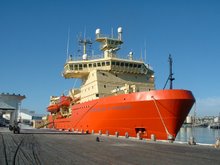today and tomorrow -- the Amundsen Sea. I think in total it will be
almost a 48-hour run to get to our next series of stations, so it's a
good opportunity to get caught up with sleep, reading, work, and the
blog.
Most of what we've done up to this point has been a little
opportunistic, and the main thrust of the work will be done in the
next few weeks. It takes so much effort and planning to get the
material, people, etc. for a cruise like this that it makes sense to
acquire as much data as possible along the way. Since the Ross Ice
shelf is on the way to the Amundsen, we used the chance to take a
series of measurements which will extend the time series of data and
can help examine long term trends in currents and temperature. We
also took a stab at making some new measurements in depressions in
the continental shelf to the east of the Ross Sea, but had to work
hard to find these troughs (because the bathymetry is poorly known)
and get to them (because the sea ice is/was thick). In the Amundsen,
because of the distance and inaccessibility (primarily due to the
year-round sea-ice) there is nowhere near the amount of data
available, and this cruise will be one of the few data points
available to understand the oceanography of the region. If you're
wondering why we're going here and why it's important to my research,
there's a page on my website -- www.princeton.edu/~cmlittle.
I'm
sure I'll get into some more details at some point when i run out of
ideas for new topics...
But I'm not there yet, thanks to some help from my audience. I have
received a few suggestions, all of which mentioned Antarctic
wildlife. And it's true I've only mentioned it in passing, so I'll
make an effort.
It's lucky that I'm on a cruise around the coast, because both the
continent and the open ocean are really poor places for wildlife
viewing. But in between these extremes, the sea ice and the coast
are spectacular. In summer, the melt-back of the sea ice, the high
nutrient concentrations (!), and the 24-hour daylight are terrific
for anything that can tolerate the -2 degree water. What are the
most exciting are of course the penguins and the marine mammals
(although the krill are pretty cute too). So in my next series of
entries I'm going to try to write about these guys:
First, I'll mention the most common sighting: Adelie penguins (2-2.5
feet tall, stereotypical black and white penguins). In the ice,
they're usually hanging around somewhere within view of the ship. I
have asked around about whether they have a tendency to travel in
groups of specific sizes, but my observations and the advice I've
gotten from the more seasoned aboard the NBP indicate that there is
no pattern. Sometimes you'll see them alone on a solitary floe in
the middle of nowhere, and sometimes they'll be tens of them all
crowded around a ridge on the ice trying to gain a better position.
They look incredibly goofy -- they're usually running away from the
ship, which is crashing through the ice, and they are never able to
decide whether it's easier to walk or slide on their bellies. They
are funny either way -- when they're sliding, they use their front
arms (wings, flippers?) to swim through the snow, when they're
walking, they hold their arms out to the side waving them around and
they move sideways almost as much as they move forward. Underwater,
they're supposed to be graceful and elegant, but unfortunately for
them, I never get to see it.
This is a topic which really deserves pictures, which is impossible
under my bandwidth-limitations -- this may be why I've avoided
talking in detail about our encounters. I do have a ton of pictures
-- personal and taken by others with much bigger lenses, and you'll
just have to wait till I can illustrate these words. It'll be worth
the wait.
C
ps nate I'm at lat 72.8S, lon 138W.


3 comments:
I recently saw a Nature or Natl Geo. special re: global warming's effects on Adelie penguins. It is thought that their days are numbered, as they will not be able to adapt to the changing climate. Emperor penguins, more adaptable, will fill the niche. Sad. (Not for the Emperors, I guess.)
thanks for the coordinates! i'll generate a new google earth map and post it to flickr for all to see!
+nate
Nate, what's flickr?
Post a Comment